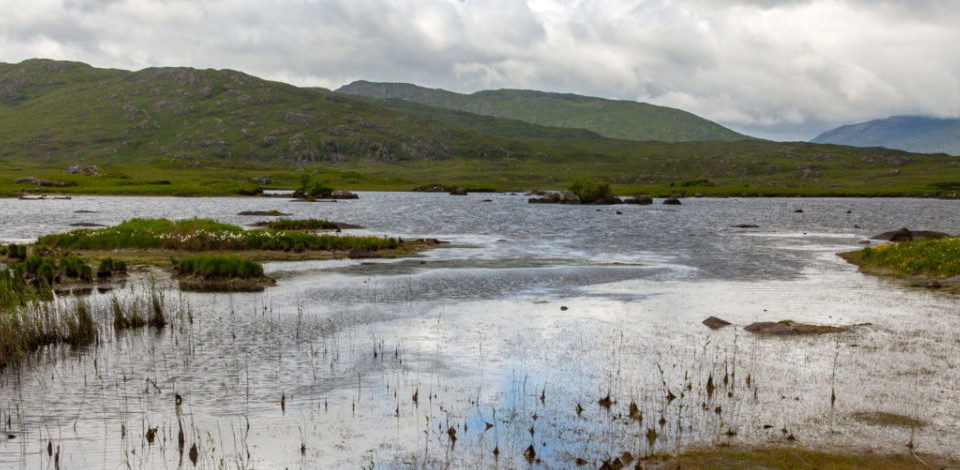The Irish government has taken bold steps to make its wetlands a core part of its climate action – a move which Wetlands International and its partners at the Irish National University of Galway and the European Inter-reg PeatCare programme have warmly welcomed.
This article was originally published by Wetlands International, here.
Last week (7 January) the Irish cabinet approved €108m funding for a groundbreaking bog rehabilitation plan led by the country’s energy company, Bord na Móna, which has its roots in peat extraction. Under the post-peat extraction scheme, more than 32.00ha of peatland will be restored by re-wetting, revegetation and colonisation of significant areas with raised bog, wetland and woodland habitats. It will make a significant contribution to achieving the State’s carbon emission reduction commitments, enhance biodiversity, create 310 jobs and contribute to Ireland becoming carbon-neutral by 2050.
At the same time, the climate change ministry has also announced that from early 2021, Ireland will report greenhouse gas emissions and removals from managed wetlands including bogs. This voluntary accounting puts Ireland on a stronger footing for accounting for greenhouse gas emissions and removals and in making the strategic changes required to support the country to meet its national, European and international climate change targets.
Accounting for emissions and removals from Managed Wetland will enhance motivation for the rehabilitation of degraded peatlands. The improvement of Ireland’s peatlands has the potential to reduce emissions and in the longer-term change them from a source to a sink and has additional benefits of securing flood defences, water management and purification alongside the potential for recreational and tourism opportunities.

According to Wetlands International partner, Niall Ó Brolcháin at NUI Galway and policy lead of the EU Care Peat project, the decisions signify a sea-change in Irish peatland policy to tackle climate change, provide green jobs and improve biodiversity at the start of the UN Decade of Ecosystem Restoration.
“This is a much needed shot in the arm for peatland restoration and rehabilitation in Ireland, a country where more than 20% of our land area is peatland. It is also a boost for Europe which has the second-largest GHG emissions from peatlands after Indonesia. Around 5% of global GHG emissions come from degraded peatlands which cover only 3% of the global land area. In terms of initiatives to reduce GHG, Ireland can go from worst-in-class to best-in-class fairly quickly if we continue to focus strongly on peatland restoration,” said Mr. Niall Ó Brolcháin.
He added: “Irish peat bogs hold nearly 4 times as much carbon as the equivalent area of tropical rain forest and twice as much as giant coniferous forests. Our peat bogs are a perhaps a hidden national treasure.”
Wetlands International has been working with the University of Galway, Greifswald Mire Centre and other partners to advise the Irish Government on the best ways to embed restoration activities into the local economy to support prosperity and a “just transition”.
Jane Madgwick, CEO Wetlands International, congratulated the Irish government for taking the step of including managed wetlands in their carbon accounting. “By recognising and counting the impacts of peatland exploitation, space is created to start recovering their natural values, including the vital
role of peatlands in the carbon cycle. We are ready to support Ireland to turn this knowledge into action, restoring amazing peatlands to benefit people and nature for the long-term,” Ms. Madgwick said.
The announcements signal positive developments for the Irish farming community. Wet agriculture, or peatland agriculture, sometimes known as “paludiculture” is likely to be included in the new EU Common Agricultural Policy meaning that those who adopt this more sustainable practice to maintain the ecosystem can be incentivised as much as conventional approaches.
Jan Peters, Greifswald Mire Centre, Germany said: “We strongly welcome the higher recognition of managed wetlands, among them especially peatlands, by the Government of Ireland by including them into the national GHG reporting from 2021 onwards as a voluntary step. Peatlands represent the largest terrestrial carbon store, in Ireland, Europe and worldwide. They are super nature-based solutions for climate change mitigation, but also for other environmental services. They can contribute to achieve Ireland’s multiple targets towards the EU Climate change policies and the Green Deal strategies”.
He added: “As the majority of drained peatlands (bogs and fens) with highest emissions are organic soils under agricultural use and can be found in the categories “Managed Cropland” and “Managed Grassland”, which will be mandatory to report from 2021, we would like to urge the Government of Ireland to follow the up-to-date guidelines of the IPCC for GHG emission reporting from wetlands, the 2013 IPCC Wetland supplement”.
According to Mr. Peters, the latest analysis of the Irish national emission inventory showed that incomplete activity data is used for organic soils in these land use categories which misses out significant parts of Irish peatland/organic soil areas. Despite organic soils’ GHG emissions are earmarked as key categories, lower quality emission factors are used in Ireland so far. No country-specific emission factors and methodology (tier 2 or 3) are applied in Ireland, which is good practice according to IPCC guidelines for key categories.

